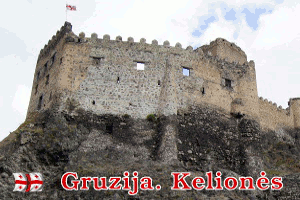Tips and facts for travelers to Western Mongolia
 |
GETING THERE By plane. From Ulanbaatar to Hovd, Olgii and Ulangom is a 2-4 domestics flights per week by domestic companies MIAT, Aero Mongolia, EZnis Airline, Hunnu Airlines. Round-trip flights for foreigners are about $300. Once per week is international flight from Alama-Aty, Kazahstan to Bayan-Olgii operated infamuos SCAT Air (It seems from 2013 no flights).
By car or bus - From Ulanbaatar by van 2-3 days, more than 1500 km. The bus to Khovd, Ölgii leaves from the Dragon Center in UB. The bus leaves three-four times a week around 1PM from UB, most days, for 65 000 MNT (Khovd), 80 000 (Ölgii) one way. Public countryside taxis and minivans, often called purgon or mekr, offer more destinations than coaches. Vehicles leave from the Black Market (Naran Tuul). There are no scheduled times for these vehicles to leave, they leave when the driver thinks his vehicle is full. Khovd to Ulaanbaatar: the vans leave from a small enclosed area across from the southeast corner of Khovd's central market. From Russia - border crossing point Tashanta / Tsagan-Nuur (Saturday-Sunday closed). From China - border crossing point Ulan-Bure / Bulgan (sometimes is a problems with citizens of other than Mongolians/Chinese).
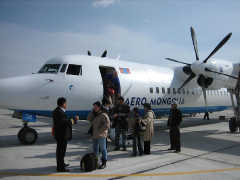 |
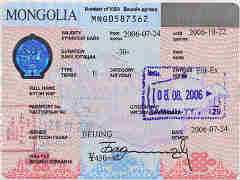 |
 |
VISAS. From 2014 European Union citizens do not need visa to stay in Mongolia up to 30 days. More information: Mongolian Ministry of Foreign Afairs
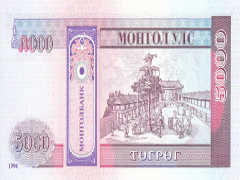 |
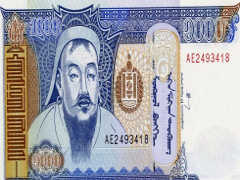 |
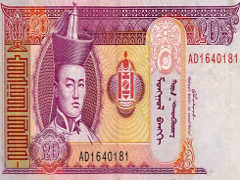 |
CURRENCY. Rates of exange: (1 USD = 1,800 MNT, 1 EUR = 2,500 MNT). Banknote denominations in circulation are 20 000 10 000, 5000, 1000, 500, 100, 50, 20, 10 tugriks. No coins. Tugrik exchange rate against the dollar and euro relatively stable - per year fells a few percent. Change currency (dollars or euros) maybe better in the markets - is faster, rate of exchange is a bit better. The banks in Ulaanbaatar also adopt the Japanese yen and Russian rubles. In country better use dollars or euro. Often in markets and small shops can be paid in dollars, but better in tugriks. In markets you need to negotiate on the price often the price can drop by up to 30 percent of the initial price. It depends on you negotiate skilss Credit cards VISA and MasterCard accepts the banks in aimag capitals towns but sometimes there can be problems with the connections. In countryside the currency exchange is very difficult or impossible. Tips - to give by your desire , usually minor. The banks are generally open from 9:00 to 17:00, shops opening hours vary greatly, but a lot of work even in late evening.
ROADS According to statistics in Mongolia is about 75 000 km of roads, but most of their is not paved ground roads - in each direction by half a dozen tracks (as a sarcastic said one traveler "in road construction is engaged entire nation" i.e. all drives where they wants). Some of roads leads to the gers, or in a place where stood the gers, some leading nowhere. Without a local guide to orient in numerous tracks pretty hard. Locals usually can only show the direction, where the roads leads is not interested to anybody. Locals drivers recognizes the roads by only to them known signs. The road signs are found very rarely usually only in the larger towns. The maintenance of roads is very bad. Maps is more disinformation than information source. A mountain river carried away the bridge, which no one restoring, the locals drivers "builds" new tracks to wade through the river. A paved road from Ulaanbaatar to Erdene (72 km east of Ulaanbaatar), as well as here is a paved road to the first capital of Genghis Khan Kharkhorin town and extends 300 km from the aimag center Arvaikheero. On tracks in mountains is large gravel, stones, even small boulders, in deserts "paved" by coarse sand and fine gravel. The main roads are not always better than less important - many of them (including paved) has a holes and "washboards". Road pits or large boulders on it is no rarity.
LOCAL TIME The central and eastern portions of Mongolia observe UTC + 8 year round. This includes Ulaanbaatar. The western portions of Mongolia observe UTC + 7 year round. This includes the Provinces or Aimags of Khovd and Bayan-Olgii.
CLIMATE. The best Mongolia travel season starts in May and hits its highest peak in July and in August when the weather is most favorable for traveling. Mongolia have 250-260 sunny days throughout the year, so you will need good UV protection. Summer (average daily temperature above +10° C) in the Mongolian Altai mountains lasts from end of May until the end of August (85-90 days) in the Great Lakes Depression and in the Gobi Altai lasts from the end of April to the end of September (150 days). Autumn (average daily temperature from +10° C till -5° C) in the Mongolian Altai mountains lasts from late August to late October (75 days), in the Great Lakes Depression from late September (40 days), in the Gobi Altai lasts from late September to first decade of November (50 days). Winter (average daily temperature below -5° C) in the Mongolian Altai mountains lasts from late October to middle of March (160 days), in the Great Lakes Depression from late October to middle of March (130-135 days), in the Gobi Altai lasts from middle of November to middle of March (150 days). Although winter in the mountains are longer but there are warmer than in the Great Lakes Depression and in the Gobi desert. Spring (average daily temperature from -5° C till +10° C) in the Mongolian Altai mountains lasts from first decade of April to late May (40-45 days), in the Great Lakes Depression and in the Gobi Altai lasts from middle of March to middle of April (approx. 40 days). Climate is purely continental. (Average daily temperatures in January is from -35° C to -10° C, in July from +15° C to +26° C, in south up to +40° C. Precipitations falls a little, mostly in the summer, 100-200 mm per year, up to 500 mm in the mountains.
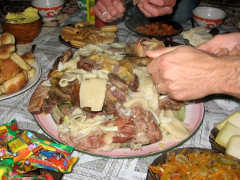 |
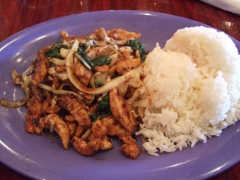 |
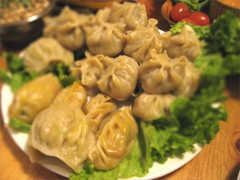 |
MONGOLIAN FOOD The main diet in rural Mongolia is mutton or sheep, occasionally beef. Mongolian national cuisine is famous for meat and dairy dishes, also pastries. A tasty and greasy dish served is khuushuur (huushoor), which is a fried dumpling stuffed with bits of mutton and onion. The boodog or goat/marmot barbecue. Mongolians are very fond a dishes of steamed, unsalted sheep. There are dishes that are known only in Mongolia: borcog - (finely cut pieces of dough, baked in sheep oil), chalmag - pies cooked from annabis seeds and flour mixture stuffed with raw meat and so on. A favorite Mongolian drink is tea with milk, butter or lard and salt. Very tasty. The national drink is called Kumys (the alcohol content is like than that of beer). This is a drink made from fermented mare's milk, and is certainly an acquired taste.
© J.D.Endriukaitis



